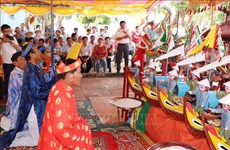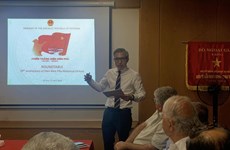Oc Eo-Ba The relic seeks UNESCO recognition
 Artefacts dating back to Oc Eo civilization (Photo: Minh Duc/VNA)
Artefacts dating back to Oc Eo civilization (Photo: Minh Duc/VNA)The 450ha Oc Eo relic is located in the area of Sap – Ba The Mountain, Thoai Son district, the Mekong Delta province of An Giang.
This is a well-known relic, first excavated by French archaeologist Louis Malleret in 1944, which is believed to have been a prosperous commercial port of the once-powerful Phu Nam kingdom 2,000 years ago.
Artifacts found in this area are clear evidence of an advanced civilisation with developed arts and crafts including jewellery and pottery making.
There were also a system of canals and various temples and tombs built with bricks and stones in this area, which were the combination of ancient civilisations in the region and the local culture.
In late 2012, the Ministry of Culture, Sports and Tourism assigned the Vietnam Institute for Culture and Arts to make a dossier on Oc Eo-Ba The relic and submit to the United Nations Educational, Scientific and Cultural Organisation (UNESCO) to seek the recognition as a world cultural heritage site.
Ever since, workshops have been held to gather experts’ ideas on building the dossier. During the events, scholars explored values of the Oc Eo culture relics in Ba The mountain and Nen Chua and proposed to formulate a plan for the preservation of the area and develop a nomination dossier to earn a UNESCO-recognised heritage title for the Oc Eo culture space in Ba The and Nen Chua relic site.
During the workshops, experts suggested the dossier focuses on three crucial selection criteria out of 10 which are explained in the Operational Guidelines for the Implementation of the World Heritage Convention, which decide if any sites are included on the World Heritage List by UNESCO. They include (1) the second criteria: to exhibit an important interchange of human values, over a span of time or within a cultural area of the world, on developments in architecture or technology, monumental arts, town-planning or landscape design; (2) the third criteria: to bear a unique or at least exceptional testimony to a cultural tradition or to a civilization which is living or which has disappeared; (3) the fifth criteria: to be an outstanding example of a traditional human settlement, land-use, or sea-use which is representative of a culture (or cultures), or human interaction with the environment especially when it has become vulnerable under the impact of irreversible change.
According to Doctor Luu Tran Tieu, Chairman of the Vietnam Cultural Heritage Association, Oc Eo civilisation grew prosperous in a vast area, where diverse vestiges could be found now, including residences, tombs, ancient urban areas and a top-tier trading centre of Southeast Asia.
 A collection of golden vestiges dating back to Oc Eo civilisation in Long An provincial Museum (Photo: Bui Giang/VNA)
A collection of golden vestiges dating back to Oc Eo civilisation in Long An provincial Museum (Photo: Bui Giang/VNA)Prime Minister Nguyen Xuan Phuc on December 2016 approved a master plan on preserving and promoting values of the Oc Eo – Ba The special national relic site in the southern province of An Giang.
The total planned area is 433.2 hectares, covering the Ba The mountainside and foot, and the Oc Eo field.
The scheme focuses on evaluating the natural and social environment as well as socio-economic criteria such as population, labour, tourism activities.
It also examines the situation of land usage, technical infrastructure, and construction investment in the relic site.
Outstanding cultural and historical features along with conservation orientations are defined under the plan.
Flourishing between the first and the seventh century, Phu Nam Kingdom covered a large area of the southern plain and hosted the Oc Eo culture in An Giang province. After being forgotten and buried for thousands of years, traces of the Oc Eo culture were discovered in Ba The – Oc Eo area in An Giang.
In 1944 French archaeologist Louis Mallecet carried out excavations at the site along with colleagues from the French School of the Far East. They unearthed objects offering proof of a flourishing civilization and well-developed trade with other areas in Southeast Asia.
People in the civilization produced various types of handicrafts, including ceramics, as well as had the ability to refine copper, iron and tin, along with creating silver and gold jewellery./.













